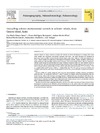Please use this identifier to cite or link to this item:
https://accedacris.ulpgc.es/handle/10553/73085
| Title: | Unravelling calcrete environmental controls in volcanic islands, Gran Canaria Island, Spain | Authors: | Alonso-Zarza, Ana María Rodríguez-Berriguete, Álvaro Martín-Pérez, Andrea Martín-García, Rebeca Menéndez, Inmaculada Mangas, José |
UNESCO Clasification: | 2506 Geología 251110 Mineralogía de suelos |
Keywords: | Aeolian Dust Isotopes Laminar Horizons Ooids Pedogenic, et al |
Issue Date: | 2020 | Journal: | Palaeogeography, Palaeoclimatology, Palaeoecology | Abstract: | Volcanic islands are unique contexts to analyze the controls on calcrete development in settings with varied relief, climate and vegetation, and lacking carbonate host rocks. This paper discusses the formation of Quaternary calcrete profiles in Gran Canaria volcanic Island, under direct influence of the SAL (Saharian Air Layer). Calcrete profiles are multi-storey and composed of prismatic, massive, laminar, pisolithic, ooid-bearing, sandy mudstones with rhizoliths and brecciated horizons. Host rocks include basalts, siliceous mudstones, volcanic sands and gravels and bioclastic-rich sands. Carbonate is mostly calcite but some dolomite occurs in massive horizons. The main microfabrics include laminated micrite, fine crystalline dolomite, desiccated micrite, micrite-clay groundmass, oriented Mg-rich clays, peloids, spherulites and coated grains. δ13C varies from −3.26 to −9.18‰ VPDB and δ18O from +0.86 to −3.24‰ VPDB. The 87Sr/86Sr ratios are between 0.707504 and 0.708860, indicating that calcium was mostly supplied from the CaCO3-rich aeolian dust coming from the Sahara Desert. Calcrete profiles are mostly pedogenic with roots and microorganisms enabling carbonate precipitation within the soils. The correlation trend of δ13C and δ18O points to a climate control on precipitation, with the heavier isotope values in the horizons containing dolomite. Sedimentation rates interplayed with calcrete formation processes and erosion to outline the profiles/horizons. Amalgamated laminar horizons formed when the rate of calcrete formation was higher than sedimentation and erosion, whereas areas or periods with relatively higher sedimentation allowed the separation of calcrete horizons. The direction of the winds supplying aeolian dust, and the varied relief, vegetation and climate favored better development of calcretes in the relatively arid and lowland areas of the eastern side of the island. Our study shows that calcretes contain the record of the paleoenvironmental controls that operated in volcanic islands with no previous carbonate substrates. | URI: | https://accedacris.ulpgc.es/handle/10553/73085 | ISSN: | 0031-0182 | DOI: | 10.1016/j.palaeo.2020.109797 | Source: | Palaeogeography, Palaeoclimatology, Palaeoecology [ISSN 0031-0182],v. 554, 109797 (Septiembre 2020) |
| Appears in Collections: | Artículos |
SCOPUSTM
Citations
5
checked on Jun 8, 2025
WEB OF SCIENCETM
Citations
4
checked on Jun 8, 2025
Page view(s)
250
checked on May 31, 2025
Download(s)
620
checked on May 31, 2025
Google ScholarTM
Check
Altmetric
Share
Export metadata
Items in accedaCRIS are protected by copyright, with all rights reserved, unless otherwise indicated.
